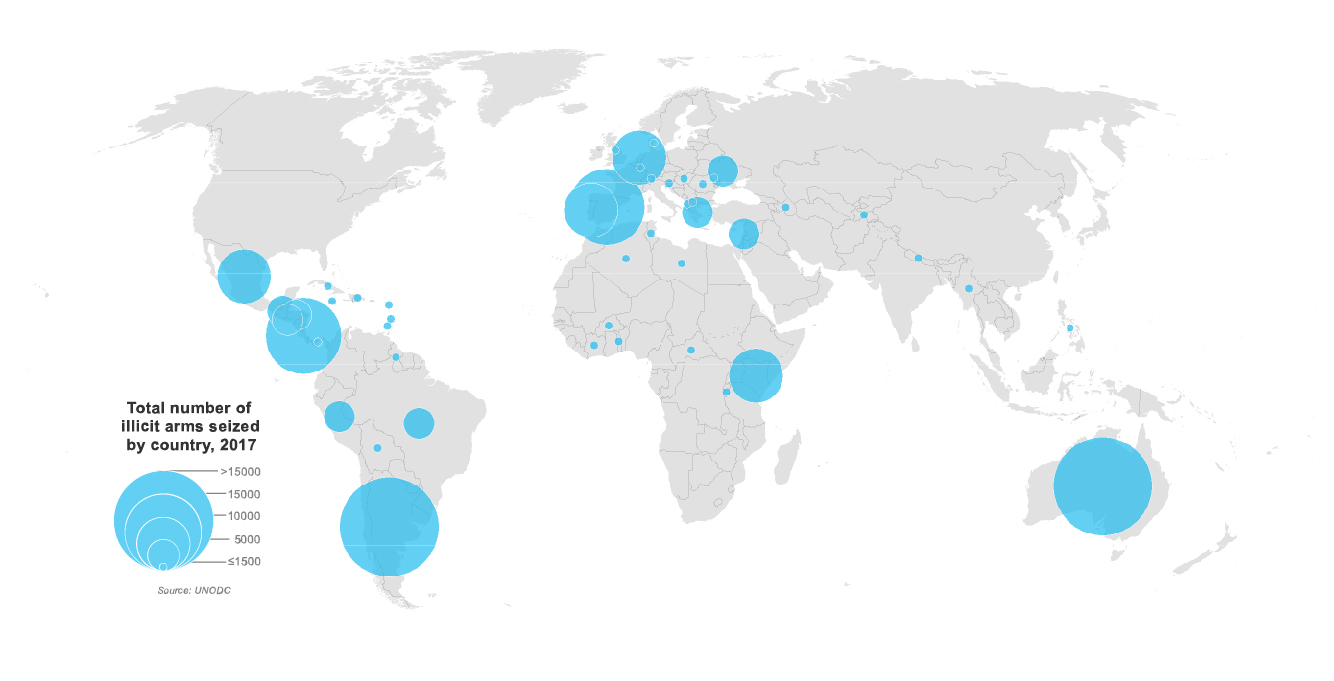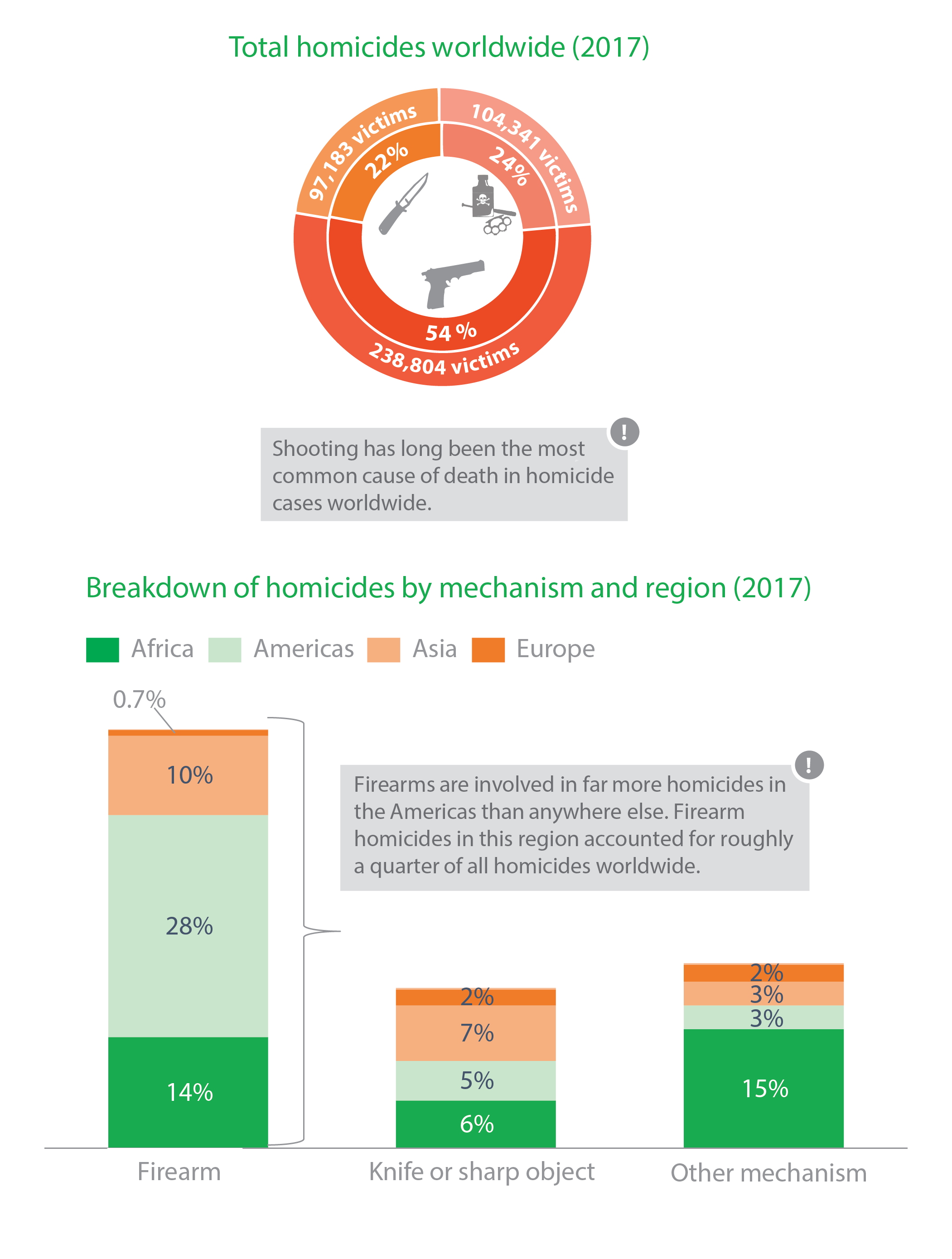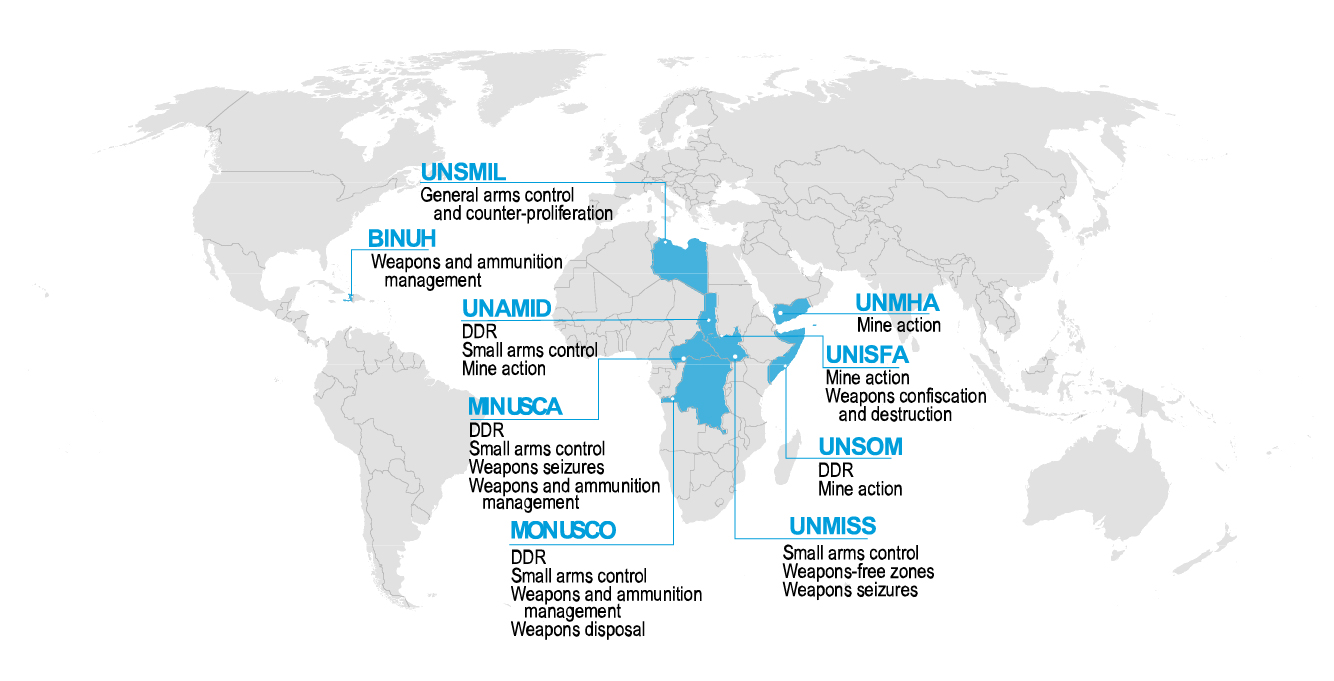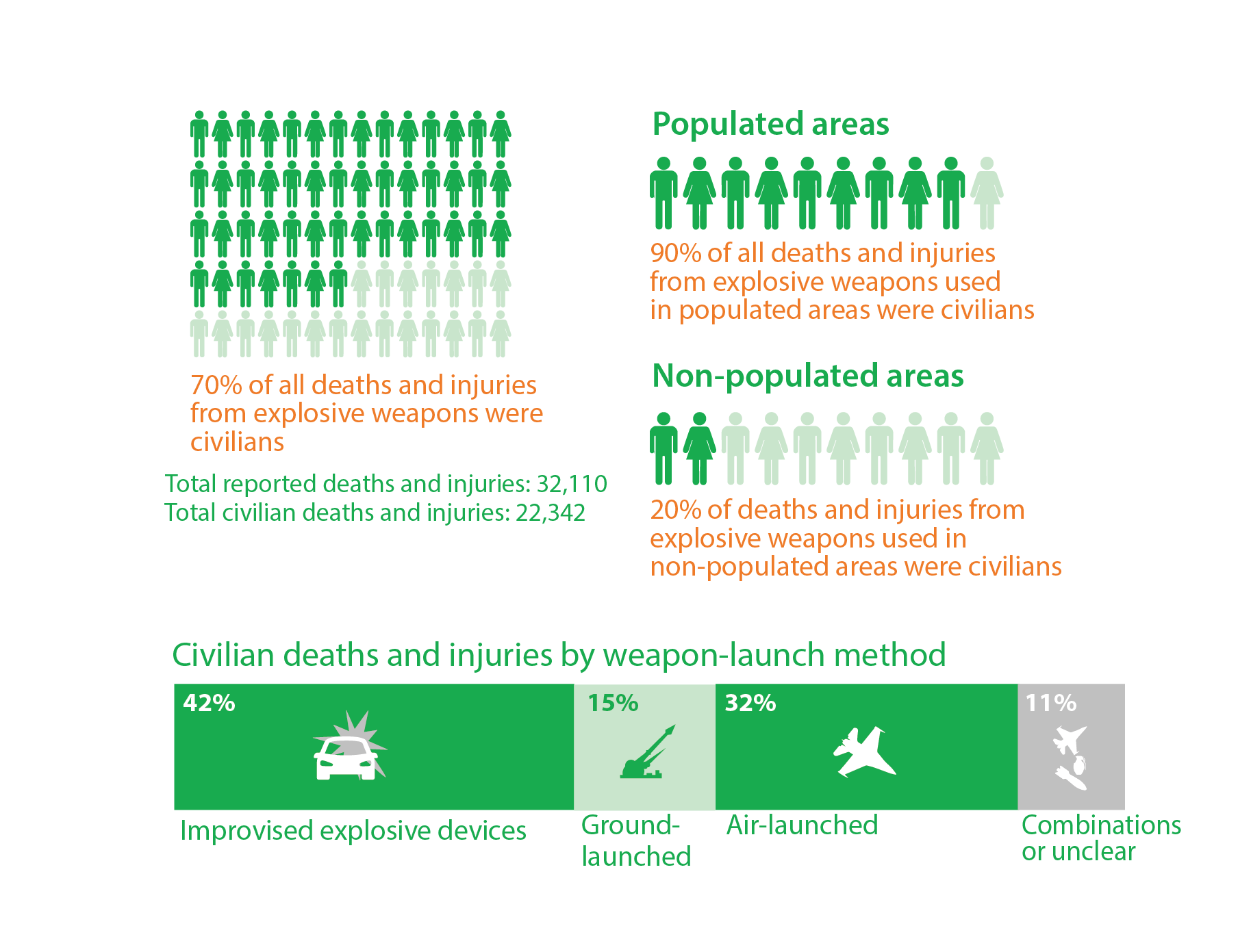Thousands of civilian lives continue to be lost because of illicit small arms and the use in urban areas of explosive weapons designed for open battlefields. New weapon technologies are intensifying risks in ways we do not yet understand and cannot even imagine. We need a new vision for arms control in the complex international security environment of today.
The challenges posed by conventional arms—their illicit trade, their accumulation and their proliferation—persisted through 2019. Of equal significance were the immediate, direct impacts of addressing, or failing to address, those challenges. In the context of conventional arms, the international community’s efforts to accomplish the Secretary-General’s vision of “disarmament that saves lives” resulted in varying levels of progress, setbacks and stasis, as in previous years.
Global sales of arms and military services increased again in 2019, reaching a level almost 50 per cent higher than in 2002, and an independent analysis found that arms flows to the Middle East had almost doubled over the previous five years. While the global authorized small arms trade recorded its highest sales since 2001, the transparency of States in that area was in decline.


National rates of illicit arms seizure reflect law enforcement capacity, not the number of illicit arms in a given region. The figures provided are based on 2017 data.
The boundaries and names shown and the designations used on this map do not imply official endorsement or acceptance by the United Nations. Final boundary between the Republic of Sudan and the Republic of South Sudan has not yet been determined.
Map source: United Nations Geospatial Information Section.
Data source: UNODC, Small Arms Survey and United Nations Operations and Crisis (Centre Research and Liaison Unit).
There are more than 1 billion firearms in circulation in the world, the vast majority of which are in civilian hands. Civilian ownership is the fastest-growing category.*

Small arms and light weapons remain drivers of armed conflict and violence.
* The terms “firearms” and “small arms” are used interchangeably in this graphic. The figures provided are based on 2017 data. Uncertainty about any firearms data requires systematic estimation that relies on a broad spectrum of sources and makes approximation unavoidable.
Data source: Small Arms Survey.
Graphic courtesy of United Nations Operations and Crisis Centre (Research and Liaison Unit).
Firearms were used to kill more than 238,000 people in 2017 .*

Firearms were involved in more than half of all homicides worldwide.
* The terms “firearms” and “small arms” are synonymous for the purposes of this graphic. Figures are from 2017.
Data source: UNODC, Global Study on Homicide 2019, booklet 3, pp. 77–88.
Graphic courtesy of United Nations Operations and Crisis Centre (Research and Liaison Unit).
Meanwhile, States parties to the Arms Trade Treaty focused on gender and gender-based violence as a priority theme for their sixth Conference. They also addressed continuing concerns about the timely submission of reports and unpaid contributions, as well as the need for the Treaty’s universalization.
In the context of ammunition management, States continued to pay increased attention to the issue of conventional ammunition as a stand-alone matter of concern. During the year, the United Nations Institute for Disarmament Research (UNIDIR) organized informal consultations, regional outreach activities and seminars, which were convened to inform and facilitate the work of a new group of governmental experts on “problems arising from the accumulation of conventional ammunition stockpiles in surplus”. The group was scheduled to begin work in January 2020. Building on informal consultations convened in 2018 in the framework of General Assembly resolution 72/55 of 4 December 2017, States actively engaged in three informal consultations organized by Germany, the resolution’s main sponsor. They were held in February, May and September 2019 at the United Nations Headquarters in New York.
In another development on the issue of ammunition, the United Nations Office for Disarmament Affairs and the Geneva International Centre for Humanitarian Demining established the Ammunition Management Advisory Team to provide technical assistance to interested States in accordance with the International Ammunition Technical Guidelines, including under the quick-response mechanism of the United Nations SaferGuard Programme. The Advisory Team was established to enhance State and regional action on safe and secure management of ammunition and to facilitate effective and sustainable international cooperation and assistance.
During the period January 1979 to December 2019, almost 30,000 deaths and injuries were recorded from unplanned explosions at munitions sites (UEMS). The highest number of casualties was recorded in 2002, mainly due to the devastating incident that occurred in Lagos, Nigeria. Similarly, the incident in Abadan, Turkmenistan, in 2011 and the one in Brazzaville, Congo, in 2012 contributed strongly to the spikes in 2011 and 2012.

Ageing, unstable and excess ammunition stockpiles pose the dual hazards of illicit proliferation and accidental explosion, which have caused humanitarian disasters and destabilization in various global regions. In view of those challenges, the United Nations developed the International Ammunition Technical Guidelines in 2011 and established the SaferGuard Programme as the corresponding knowledge management platform, at the request of the General Assembly. The Guidelines constitute practical, modular guidance on the safe and secure management of ammunition, which benefits United Nations personnel in the field, interested States and other relevant stakeholders .
Source: Small Arms Survey
The Security Council, for its part, remained seized of the issue of small arms and light weapons, including the role of weapons and ammunition management in support of peace operations. In December, the Secretary-General issued his sixth biennial thematic report on small arms and light weapons to the Council, providing an overview of relevant trends and developments in that area over the previous two years. In that regard, particular emphasis was placed on the prioritization of “disarmament that saves lives”, including a call for enhanced efforts on small arms and light weapons at the national level. The Secretary-General concluded that the destabilizing accumulation, illicit transfer and misuse of small arms and light weapons continued to initiate, sustain and exacerbate armed conflict and pervasive crime.

The United Nations deploys peacekeeping and special political missions in support of a particular country or region, as mandated by the Security Council or General Assembly. Currently, there are more than a dozen United Nations peacekeeping operations that are helping States navigate the pathway to peace, while over 20 special political missions are engaging in conflict prevention, peacemaking and post-conflict peacebuilding .
An increasingly common feature of those missions is the inclusion of conventional weapons-related provisions in their mandates .
Whether through disarmament, demobilization and reintegration (DDR) technical support, mine action and clearance activities, weapons and ammunition management, or small arms and light weapons control, the United Nations has been increasingly asked to support national authorities in addressing various issues related to conventional weapons, including their illicit flow and circulation .
Weapons and ammunition management has become an especially critical component of United Nations peacekeeping operations. In settings where weaponry is not properly secured, there is greater potential for outbreaks of renewed conflict and endemic crime .
In mandating peacekeeping and special political missions, States have recognized the colossal negative consequences of the illicit circulation and misuse of conventional weapons. United Nations missions have been requested to support national authorities in a range of areas, from management and storage of weapons to destruction and disposal to identification and clearance of mines .
The boundaries and names shown and the designations used on this map do not imply official endorsement or acceptance by the United Nations. Final boundary between the Republic of Sudan and the Republic of South Sudan has not yet been determined.
Mandates as of 26 March 2020.
Abbreviations: BINUH=United Nations Integrated Office in Haiti; MINUSCA=United Nations Multidimensional Integrated Stabilization Mission in the Central African Republic; MONUSCO=United Nations Organization Stabilization Mission in the Democratic Republic of the Congo; UNAMID=African Union-United Nations Hybrid Operation in Darfur; UNISFA=United Nations Interim Security Force for Abyei; UNMHA=United Nations Mission to Support the Hudaydah Agreement; UNSMIL=United Nations Support Mission in Libya; UNMISS=United Nations Mission in South Sudan; and UNSOM=United Nations Assistance Mission in Somalia.
Map source: United Nations Geospatial Information Section.
Data source: United Nations Operations and Crisis Centre (Research and Liaison Unit).
Reporting by Member States to the United Nations Register of Conventional Arms and in the United Nations Report on Military Expenditures trended downwards from the previous year, underscoring a decade of marked decline. Encouragingly, however, the proportion of States reporting transfers of small arms and light weapons as part of their reporting to the Register held generally steady, at 73 per cent. A recommendation on small arms and light weapons in that context was, in fact, one of the key outcomes of the 2019 Group of Governmental Experts on the Register (for more information on the Group, see p. 105).
The increasing attention to the gender dimension of conventional arms issues represented a continuing and welcome trend in 2019. That was reflected in, for example, the strong gender-relevant language and discussions during the fifth Conference of States Parties to the Arms Trade Treaty, as well as in the framework of the Programme of Action to Prevent, Combat and Eradicate the Illicit Trade in Small Arms and Light Weapons. The focus has now shifted to supporting States in their implementation efforts of those international commitments. (For more information on gender and disarmament, see chapter VI.)

In 2001, States adopted by consensus the Programme of Action to tackle the scourge of illicit flows of small arms and light weapons. Four years later, the adoption of the International Tracing Instrument further strengthened the framework .
To implement both instruments fully and effectively, it is critical to enhance international cooperation and assistance. To that end, Governments of countries particularly affected by a challenging security situation have been sharing information on their need for assistance for small arms control through biennial national reports .*
A growing number of States are submitting those national reports as the result of remarkable improvements in how the contents are being put to work. With growing opportunities to match needs with available resources and improving capabilities to measure implementation progress, States are reaffirming their commitment to the Programme of Action process .
The number of requests for assistance has jumped since 2014, as growing concern about weapons diversion to black markets and unauthorized recipients has prompted a push for improved government control over international transfers, stockpile management, and marking and record-keeping. Implementation of the Arms Trade Treaty has scaled up in parallel, encouraging Governments to seek assistance on international arms transfers through synergies with the Programme of Action and the International Tracing Instrument. Meanwhile, requests related to weapons collection have increased amid efforts to gather data in support of target 16 .4 of the 2030 Agenda for Sustainable Development .
* In reports on country-level implementation of the Programme of Action, national small arms authorities can make requests for relevant financial and technical assistance. Such requests are addressed to other Governments, intergovernmental and regional organizations, and international non-governmental organizations.
In addition, the Office for Disarmament Affairs partnered with the United Nations Development Programme (UNDP) to launch the Saving Lives Entity, a facility designed to support Member States in tackling illicit small arms and light weapons as part of a comprehensive approach to sustainable security and development. The aim was not only to address specific problems, but also to change cultural attitudes and perceptions regarding small arms, including resistance to women’s involvement in decision-making and conflation of masculinity with gun ownership. As at the end of 2019, work was under way to identify initial pilot activities to be carried out under the facility.
The continued development of the Modular Small-arms-control Implementation Compendium included planning for new modules and the translation of existing modules. The growing availability of modules in languages other than English continued to be seen as critical to the overall function of the Compendium by providing increased access to the best expert advice on small arms in succinct operational terminology.

When explosive weapons are used in populated areas, civilians bear the brunt .
In the Agenda for Disarmament, the Secretary-General places special emphasis on addressing the use of explosive weapons in populated areas and has committed to supporting Member States in their efforts to develop a political declaration as well as appropriate limitations, common standards and operational policies, in conformity with international humanitarian law .
Data source: 2018 English-language media reports and Action on Armed Violence, 2018 Explosive Violence Monitor Report, pp. 5–6.

Explosive remnants of war found close to the United Nations Mission in South Sudan compound in Juba for destruction by the United Nations Mine Action Service, 20 March 2019.
Photo credit: UN Photo/Nektarios Markogiannis